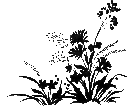 |
The Preserve |
News and Events |
Natural History |
The Trail |
Monitoring |
Restoration |
Library |
Organization |
|
Todmorden Mills Wildflower Preserve
|
Nature NotesYour Nature Guide for the week September 6-September 12SpidersPeer into the vegetation along the woodland trail and chances are you will find a dinner-plate-sized spider web suspended horizontally between the lower branches of a shrub or among the stalks of wildflowers. Off to the side of the web, waiting in a tunnel, is the Grass Spider, a type of funnel-web spider that is about 2 cm long with relatively long legs. Above the web, a few silken guy "wires" criss-cross the space: small flies or beetles that hit the guys often tumble into the web. The spider must react quickly as the web is not very sticky, and the prey could escape. As soon as the spider senses the vibrations of the struggling insect it rushes out to grab its prey, and usually drags it back into the tunnel. WildflowersIn the meadow, and in many sunny places along the trail, the glorious tall yellow sprays of Canada Goldenrod stand out brightly among the other vegetation. There are several species of goldenrod at the preserve, including the smaller Zig-zag Goldenrod which prefers somewhat shadier habitats along the woodland trail. Less abundant than goldenrods, but just as lovely, are the asters. Like goldenrods, the asters are a diverse group in the Sunflower family. The different species of asters vary in flower colour: most are white or shades of purple and blue. Leaf morphology is variable also: some species have narrow, almost spiny leaves, and others have fat, heart-shaped leaves. At Todmorden the most conspicuous aster species is the New England Aster. The "flowers" are actually flower heads composed of many small flowers (florets). The yellow centre, which looks like a mass of pistils and stamens, is actually packed with tiny but complete tubular flowers, called disk or tube florets. Surrounding the central portion of the flower head are showy purple strap-shaped ray florets, which look like (but which are not) petals. The showy purple ray florets are usually sterile and do not form seeds. They do, however, attract and provide stable "landing sites" for potential pollinators such as bees, paper wasps and butterflies. The central yellow disk florets secrete nectar which rewards visitors. A seedhead packed with tiny seeds begins to form after pollination of the disk florets. ShrubsAround the pond, the Common Elderberry shrubs are now laden with ripe fruit. The deep red drupelets (small stone fruits) hang in clusters so large and heavy that the soft-pithed Elderberry branches bend readily under the weight of the fruit. Hollowed-out Elderberry twigs were once made into simple reed instruments, and they were also used as taps for sugar maple sap. Elderberry fruit was commonly used by early settlers to make wine and a very palatable jelly--in fact it is still used to make these tasty products today. BirdsBirdsong has been noticeably absent from the wooded portion of the Preserve since the end of the nesting season, in about mid-July, and, save for the sounds of cicadas and tree crickets, the woods have been eerily quiet. In the next few weeks though, the chirps and reedy peeps of warblers and other fall migrants en-route to southern wintering grounds will be heard. It is hard to predict exactly when migrants will be present in the Preserve. Typically, small flocks of birds arrive, feed, "rest-up", and move on. Nature Notes is researched and written by Mike Dennison and Alejandro Lynch, and is published each week by Hopscotch Interactive (www.hopscotch.ca). In addition to this online version, Nature Notes is available as a print-friendly PDF and as a text-only email version. Please contact Mike Dennison to receive these, or for more info (tel: 416-696-7230, email: dennison@hopscotch.ca). |
| Copyright © 2003-2004 Todmorden Mills Wildflower Preserve |